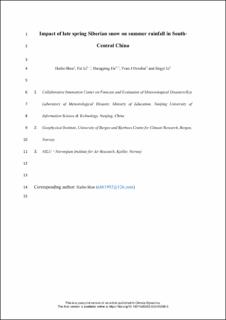| dc.contributor.author | Shen, Haibo | |
| dc.contributor.author | Li, Fei | |
| dc.contributor.author | He, Shengping | |
| dc.contributor.author | Orsolini, Yvan | |
| dc.contributor.author | Li, Jingyi | |
| dc.date.accessioned | 2021-07-07T08:29:14Z | |
| dc.date.available | 2021-07-07T08:29:14Z | |
| dc.date.created | 2020-03-25T15:04:31Z | |
| dc.date.issued | 2020 | |
| dc.identifier.issn | 0930-7575 | |
| dc.identifier.uri | https://hdl.handle.net/11250/2763668 | |
| dc.description.abstract | Located in the Yangtze River Valley and surrounded by mountains, South-Central China (SCC) frequently suffered from natural disasters such as torrential precipitation, landslide and debris flow. Here we provide corroborative evidence for a link between the late spring (May) snow water equivalent (SWE) over Siberia and the summer (July–August, abbr. JA) rainfall in SCC. We show that, in May, anomalously low SWE over Siberia is robustly related to a large warming from the surface to the mid-troposphere, and to a stationary Rossby wave train from Siberia eastward toward the North Atlantic. On the one hand, over the North Atlantic there exhibits a tripole pattern response of sea surface temperature anomalies in May. It persists to some extent in JA and in turn triggers a wave train propagating downstream across Eurasia and along the Asian jet, as the so-called Silk Road pattern (SRP). On the other hand, over northern Siberia the drier soil occurs in JA, accompanied by an overlying anomalous anticyclone through the positive feedback. This anomalous anticyclone favors the tropospheric cooling over southern Siberia, and the meridional (northward) displacement of the Asian jet (JMD) due to the change in the meridional temperature gradient. The combination of the SRP and the JMD facilitates less water vapor transport from the tropical oceans and anomalous descending motion over SCC, and thus suppresses the precipitation. These findings indicate that May Siberian SWE can be exploited for seasonal predictability of SCC precipitation. | en_US |
| dc.language.iso | eng | en_US |
| dc.publisher | Springer | en_US |
| dc.title | Impact of late spring Siberian snow on summer rainfall in South-Central China | en_US |
| dc.type | Journal article | en_US |
| dc.type | Peer reviewed | en_US |
| dc.description.version | acceptedVersion | en_US |
| dc.rights.holder | Copyright Springer-Verlag GmbH Germany, part of Springer Nature 2020 | en_US |
| cristin.ispublished | true | |
| cristin.fulltext | original | |
| cristin.fulltext | postprint | |
| cristin.qualitycode | 1 | |
| dc.identifier.doi | 10.1007/s00382-020-05206-5 | |
| dc.identifier.cristin | 1803539 | |
| dc.source.journal | Climate Dynamics | en_US |
| dc.source.pagenumber | 3803-3818 | en_US |
| dc.relation.project | Norges forskningsråd: 244166 | en_US |
| dc.relation.project | Norges forskningsråd: 276730 | en_US |
| dc.relation.project | NILU - Norsk institutt for luftforskning: 115089 | en_US |
| dc.identifier.citation | Climate Dynamics. 2020, 54, 3803-3818. | en_US |
| dc.source.volume | 54 | en_US |
